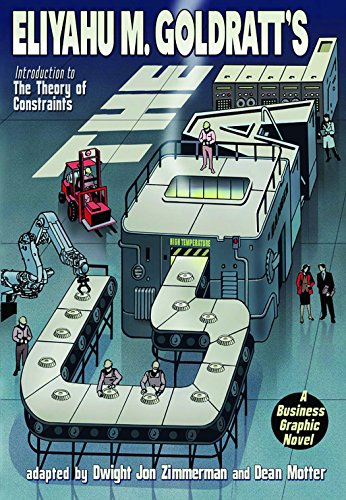The Goal - A Business Graphic Novel

The Goal: A Business Graphic novel is crass, outdated and overly on the nose. At the same time, it is a relatively entertaining illustrated introduction to a boring idea (a management paradigm). For this alone, I can't help but recommend it.
Alex Rogo directs a plant at Unico. He’s struggling to turn his business around and the CEO has just given him an ultimatum. I've never read a business novel before, and the combination of words is surprising. Is Rogo up to his managerial task? (Of course, otherwise there would be no hero's journey... But how?) Like “Obi Wan Kenobi instructing Luke Skywalker on the use of the force”, his former professor turned consultant Jonah saves the day.
The formulation of a business seems very crass and slightly outdated. None of this ESG shit; the goal is to make money. How? In a nutshell:
- Maximize throughout: the rate at which the system generates money through sales.
- Inventory: all money the system has invested in purchasing things it intends to sell.
- Minimize operational expenses: all money the system spends in order to turn inventory into throughout.
I enjoyed the vignette of Alex Rogo taking a group of boyscouts including his son on a backpacking trip. He is faced with the challenge of making sure everyone safely arrives at the destination and managing their various abilities. One boy, Herbie seems to always be lagging behind, slowing the group down. When Rogo investigates, it turns out that he is carrying the large and heavy tent. By redistributing the tent parts between the rest of the boys, everyone is slightly more burdened, but the group is able to establish a much faster pace.
This boyscouts story is directly analogous to the factory production line, where some resources are bottlenecks:
- Bottleneck resources - capacity is less than or equal to demand placed on it. It's a constraint
- Non-bottleneck resources - capacity is greater than demand.
And so this is Eliyahu M. Goldratt's Theory of Constraints: look for bottlenecks and optimize the system accordingly. In the fictional plant in the story, quality control initially happened after an expensive bottleneck. One of Jonah's insights was that it was far more efficient to do quality control before the bottleneck and discard parts before they pass through the expensive bottleneck.
Bottlenecks should always have a queue waiting on them. They are critical pieces that, if scaled, would greatly improve efficiency. Conversely if they sit idle, it’s a complete waste of resources. A bottleneck sitting idle means the whole plant is effectively sitting idle, with no throughput.
But also having huge queues of parts waiting on a bottleneck is a bad idea. It means somewhere in the system something is working too hard. So running non-bottleneck resources at maximum capacity is dumb. It’ll just create a giant queue of stuff stuck in the bottleneck. Reallocate resources.
Jonah suggests: work backwards from total throughput to have each part of the process output parts at the right rate. So avoid massive queues and make sure bottlenecks are operating at 100%.
Of course once the bottleneck has been resolved throughout increases. And now another bottleneck is in the way. And so on. This is essentially an optimization process.
A funny parable to summarize the concept involves Jonah visiting the Rogo household and having the kids devise solutions to the Herbie hiking problem. His daughter suggests the boyscouts march to the best of a drum (i.e. constrained by the bottleneck), while his son suggests they also provide ropes so that the campers stay close together but without too much rigidity (ie. to be more resilient if there are random fluctuations.)
The whole book has a sleazy vibe to it. In one scene, Alex bets the head of sales that they will produce a quantity of units a new pair of Gucci loafers. And in the end, Alex wins the battle with the terrible accounting division, who is trying to subdue Alex's creative problem solving. Gotcha!